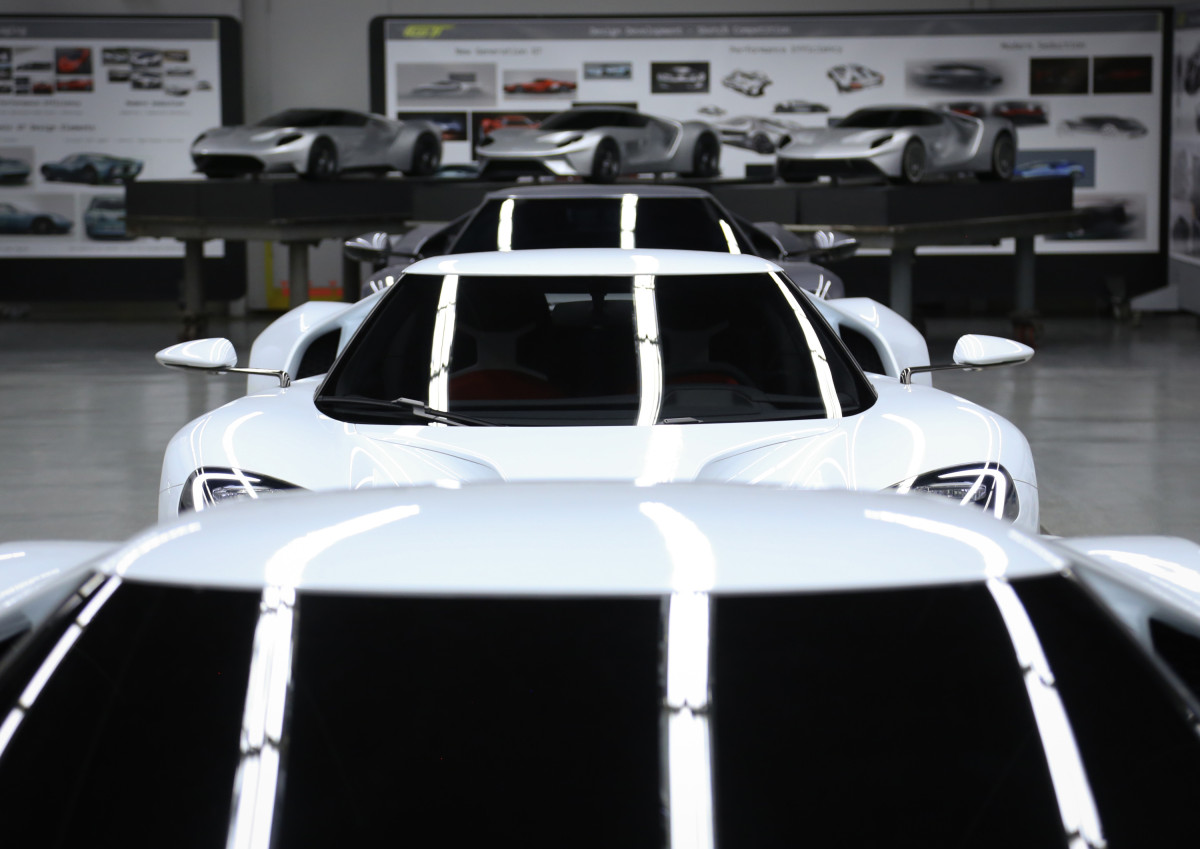Creating The New Ford GT: The Inside Story

50 years ago, Henry Ford II witnessed the culmination of a mission he launched in 1963. After Enzo Ferrari had approached Ford about investing in his struggling car company, the deal started unravelling at the 11th hour because of Ferrari’s insistence on racing his cars at Indy. Hank the Deuce said no and Il Commendatore pulled out, costing Ford millions of dollars.
Mr. Ford took this slight personally and vowed to make Ferrari pay. He called Carroll Shelby who pulled together an all-star team to create a car that could take from Enzo the thing that mattered most, his company’s domination at the 24-hours of Le Mans. In just three short years it happened. The legendary Ford GT40 Mk II finished 1, 2, 3 at the world’s most important endurance race.

30 months ago, to honor the 50th anniversary of that sweep, Ford Director of Product Development and the company’s chief technical officer, Raj Nair, gathered a team of about 10 design and engineering all-stars from within the company and told them their mission was to win Le Mans again. The team made the case for the program and sold it to Ford’s chairman and board of directors. And with that “Project Phoenix” was born.
In the summer of 2013, the team was given a room in the basement of the Ford Product Development Center and told to keep their efforts quiet. Ford didn’t want any hint of their intentions being known until they made this announcement at Le Mans last year.
In the meantime the team had to develop a car from scratch that could not only win the most gruelling event in sports car racing, but also be viable road-going vehicle that would make money for the company – which is why about 250 lucky individuals will be able to buy a street version of the GT later this year for about $400,000 a piece.
I met with four of the leaders of this project, Garen Nicoghosian – Design Manager, Exterior; Jamal Hameedi – Ford Performance Chief Engineer; Chris Svensson – Design Director, Americas; and Amko Leenarts – Director, Interior Design, to get the inside story of how the 2016 Ford GT came to be and learn more about this special car in advance of its racing debut in Daytona on 30 January 2016.

I was led to the secret design studio deep in the bowels of the building where most of Ford’s cars are conceived. It’s not a glamorous space. In fact, rumor has it, the room itself was built as a bomb shelter during the Cold War. Kept under lock and key behind a heavy metal door the Ford GT was developed in secret for nearly 18 months before they revealed the street version at the North American International Auto Show in Detroit last January. Walking into the space past the life size foam models and a CNC machine that was milling a prototype part, I could feel the energy from the project still vibrating in the room. The walls were lined with sketches of the various ideas that were proposed throughout the development process. Turning the corner I was stopped in my tracks by the the full-size painted GTs, one the original clay model and another the final prototype used as a proof of concept for manufacturing. The questions were flying through my head and I couldn’t wait to get started

When I asked what were the key factors that influenced the design and engineering choices made on the car, Jamal Hameedi was quick to answer, “Our goal is to win Le Man, which is a very fast track, so there were really two key considerations: lightweighting and aero.” That led to very different design choices from the previous GT released in 2005 which was never designed for racing. The team still wanted to connect to the heritage of the first generation GT40, however, so they carried forward some of the original concepts, but reinterpreted them for modern racing.

The first is the triangular, plexi covered headlights which bear a very familiar resemblance to the 1966 GT40. The wrap-around windshield and air intake ports behind the front door are also reminiscent of the original car. And in the rear, the round tail lamps, which also serve as exhaust ports for the oil coolers and intercoolers, are also drawn straight from the ’60s version. But this car had to be different given the changes in racing over the years.
“We needed to create as small a frontal area as possible to reduce drag,” said Chris Svensson. “So that meant we had to narrow the cockpit as much as possible.” You can see how the GT cockpit has a narrow front that tapers off like an LMP (Le Mans Prototype) car. But because this must also be a road car it has two seats. This narrowing of the cockpit means the driver and passenger sit literally shoulder to shoulder with a very narrow console between them. “We legally couldn’t make it any smaller,” Svensson said.
This presents a very different profile from the original GT40 and drove a second, and more controversial choice, the engine. The new GT is fitted with a 3.5 Liter twin-turbo EcoBoost V6 that makes over 600 horsepower. The car that won Le Mans in 1966 – and the heart of Ford’s racing heritage – was powered by a mammoth, naturally-aspirated, 7-liter V8 making 485 horsepower. Using a V6 in this car was not an easy decision, Hameedi said, “It was very emotional. But we couldn’t let history prevent us from being successful.” I was told there was no way they could fit a V8 in the GT and achieve both the weight and aerodynamic targets that could lead to success at Le Mans.

Once those decisions were made, Garen Nicoghosian said the process was almost seamless, “The real success of this project is how the design and engineering teams came together to create this amazing car. We’d have ideas and they’d either find a way to make them work or help us come up with a better idea as we went along. The process was very different from how we usually work where we sketch up a full car and then turn it over to engineering to figure it out.”
Developing the interior of the car required just as much creativity. To keep weight down and provide the strength necessary, the entire cockpit is a tub created in carbon fiber from a single mold. According to Amko Leenarts, “we started with the driver and built the cockpit around him. Knowing we had limited space, our first decision was to create a fixed seat and have the pedals and controls move to the driver.” This allowed for the long sloping glass up front without having to worry about compromising headroom and safety for drivers with shorter legs. This meant moving all the controls to the steering wheel, so the designers eliminated things like wiper and blinker stalks putting them on the front of the wheel along with other controls for the engine, suspension and media center.

As the car came together they had to take it out and test it. But they couldn’t let anyone know. So they created special covers for the car that made it look like a pickup truck when it was being flat-bedded to a track for testing. Testing was always done on odd days and off hours when the Ford test track was closed and no prying eyes were around to leak information about the upcoming supercar.

In the end, all the effort paid off. The launch of the GT in Detroit at the 2015 auto show and the subsequent announcement of a return to Le Mans were well-orchestrated surprises to most in the media, auto industry, and general public. For a final word on the GT before its race weekend, I’ll turn to Leenarts. When I asked the team what they expect from the inaugural race this weekend at the 24-hours of Daytona, he said without hesitation, “We expect to win.”
I’d say, they already have.



